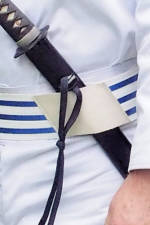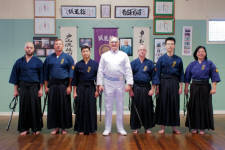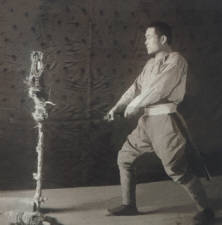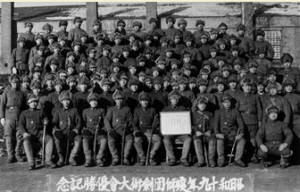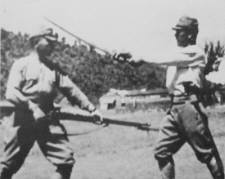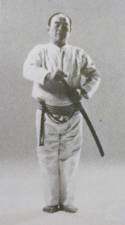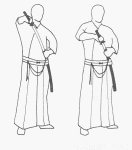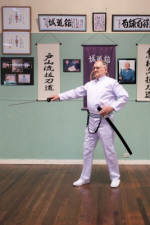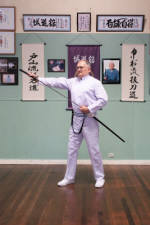
TOYAMA RYU the way of the military sword

This type of uniform has been in use by the Japanese military from ca. 1925 on and is still worn by the Japanese Self-Defence Forces with its original stable-belt, an 8cm wide white canvas-belt which is buckled up at the rear.
The uniform is made of white canvas; based on the European cavalry fatigue duty uniform and introduced by either the French or Prussians (Germans ) during the modernisation of Japan's armed forces in the late 19th century. And, at some occasions, is still worn by Toyama sword-instructors and the All Japan Jukendo (bayonet) Federation members. But, and because of it's military connection, has eventually been replaced by the kendo uniform.
The uniform comprises of white trousers, a jacket with a stiff Nehru collar and a bare white canvas-belt.
Rankings are indicated on the belt by long horizontal stripes: Instructor: 2 stripes for Renshi; Senior/Master-Instructor: 3 stripes for Kyoshi and 4 stripes for Hanshi respectively. Red stripes are worn by the military while blue stripes are worn by non-combatants.
To carry the sword a leather pocket is permanently attached to the left side of the belt and a leather strap on to the right side to accommodate the sword-cord. Once the sword has been placed through the pocket it will sit tight: pointing down some 60 degree; giving the wearer very little room to adjust or manoeuvre the scabbard saya as one would in classic sword-styles koryu or iaido; it's for this reason that the Toyama noto needs to be performed at a much steeper angle (45 degree) with the right hand at shoulder height.
Toyama Ryu Battodo is based on the practical application of the sword as a weapon. It consists of basic cutting techniques, basic kata, advanced two man kata and a variety of specific cutting patterns. It places significant emphasis on the importance of actual cutting with the sword and understanding the intricate details. It focuses on not only the physical details of every action involved in using the sword, but also the mental and spiritual meaning which also must play an equal part in understanding the sword as was once done long ago.The Rikugun Heigakko (Officer Academy) was established in 1868 at Kyoto to graduate leaders for the new Mejiji Restoration army. It later became the parent school of the Rikugun Toyama Gakko, Toyama Army Academy, which was established in 1873 to teach officers and non commissioned officers.
Its official name was the Rikugun Heigakko-ryo Toyama Gakko Shuco-jo.
In 1874 it was renamed “Toyama Military Academy” and came under the jurisdiction of the Army Academy; in 1875 it came under the jurisdiction of the Army Ministry to teach the military arts of, knife fighting, bayonet fighting, sword fencing, ju-jutsu and sumo.
To ensure the rapid modernisation of the army, the Minister of Military Affairs designed the new post Tokugawa army after the French model; French officers were engaged to staff the academies and oversee the training. After France lost the Franco-Prussian War in 1871, the Vice Minister of Military Affairs, Yamagata Aritomo (later Prime Minister from 1889-91; and 1898-1900) wanted to adopt the Prussian military system; however, because of the conservative nature of the Ministry, he was not able to effect the changes until 1878, after becoming the Minister of Military Affairs.
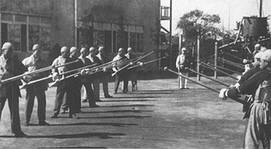

Sgt. Major Nakamura.
1944 Divisional kenjutsu Competition Grand Champions Commemoration. Front row far right (squatting) Nakamura sensei.
Tameshigiri by Sgt. Nakamura,
Sgt. Nakamura teaching bayonet drills at the Youth School ( Rikugun Toyama Gakko)
Sergeant Nakamura conducting sword v bayonet drills at Camp Jinmu (North China-Soviet border) 1944.
Nakamura sensei and daughter Kyoko performing spear v sword forms at the Yoshida Middle School 1958.
Nakamura sensei dressed in the Toyama drill uniform ca. 1952.
Sei Do Kan students with Fricke sensei in his Toyama uniform 2015.
Japanese made Toyama drill uniform with canvas belt.
Toyama sword belt with leather pocket to accommodate the sword.katana..
Copyright (C) 2013 SSJS, Sei Do Kan
NOTO the Toyama ryu way.
CHIBURI the Toyama ryu way.

